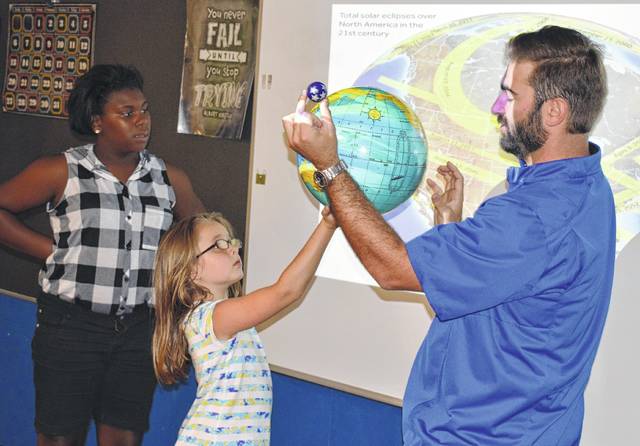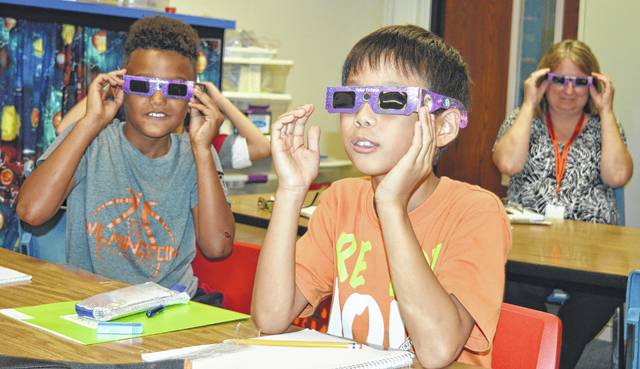

WILMINGTON — Much of America including Clinton County will see at least part of the total solar eclipse — where the moon completely covers the sun tracking from the Pacific to the Atlantic on Monday, Aug. 21.
According to the National Weather Service, the shadow of the moon will track over parts of Oregon, Idaho, Montana, Wyoming, Nebraska, Kansas, Missouri, Illinois, Kentucky, Tennessee, North Carolina, Georgia and South Carolina.
Unfortunately, no one in the local forecast area will be able to see a “total” solar eclipse that day; however, you won’t need to travel that far to witness the spectacle — the total eclipse may be seen in western Kentucky or middle Tennessee, according to the NWS.
In Clinton County, the eclipse can be seen from about 1:02-3:52 p.m. with the maximum viewing time at 2:29 p.m.
An eclipse occurs when the sun, earth and moon move into alignment with each other. One of the bodies blocks the view of another and creates a shadow.
There are two different types of eclipses — solar and lunar. A lunar eclipse happens at nighttime and occurs when the earth passes between the sun and the moon creating a shadow on the moon. These types of eclipses occur about 2-4 times per year. A lunar eclipse will generally last for a few hours.
According to NASA, there have been 15 previous eclipses over the continental U.S. since 1503 — the last in 1970 and before that in 1918, 1900, 1889 and 1878.
Locally
A viewing party open to all ages will be held 1:30-3 p.m. Monday, Aug. 21 at the Wilmington Public Library including activities, refreshments and viewing glasses (for the first 50 participants).
Area school districts have distributed and posted the below message:
“… Safety is always a top priority for the [school district]. We will take all precautionary measures with both students and staff to make this experience both safe and enjoyable. Regular sunglasses, even dark ones, are NOT safe for looking at the eclipse.
“Students will not be permitted to look at the un-eclipsed or partially eclipsed sun through unfiltered cameras, telescope, binoculars or other optical devices, with or without glasses. Some of our classes may observe the scientific phenomenon through safe, scientific methods. The eclipse can be safely seen from the NASA.gov web site. All buildings will be carefully limiting time outside for protection.
“Because of these safety concerns, we will communicate to students that when they are dismissed from school to avoid looking directly at the sun. The peak of the eclipse will end before any of our elementary students are dismissed. We encourage our families to discuss your expectations for students to not look directly at the sun during dismissal time.
“We will celebrate this event in a safe manner.”
For everyone’s safety
Looking directly at the sun is unsafe except during the brief total phase of a solar eclipse (“totality”), when the moon entirely blocks the sun’s bright face, which will happen only within the narrow path of totality.
According to information provided by NASA, the only safe way to look directly at the uneclipsed or partially eclipsed sun is through special-purpose solar filters, such as “eclipse glasses” or hand-held solar viewers. Homemade filters or ordinary sunglasses, even very dark ones, are not safe for looking at the sun.
To date four manufacturers have certified that their eclipse glasses and handheld solar viewers meet the ISO 12312-2 international standard for such products: Rainbow Symphony, American Paper Optics, Thousand Oaks Optical, and TSE 17.
NASA reports that you should beware as some companies may be selling paper solar glasses that are unsafe.
Always inspect your solar filter before use; if scratched or damaged, discard it. Read and follow any instructions printed on or packaged with the filter. Always supervise children using solar filters.
Stand still and cover your eyes with your eclipse glasses or solar viewer before looking up at the bright sun. After glancing at the Sun, turn away and remove your filter — do not remove it while looking at the sun.
• Do not look at the uneclipsed or partially eclipsed sun through an unfiltered camera, telescope, binoculars, or other optical device. Similarly, do not look at the sun through a camera, a telescope, binoculars, or any other optical device while using your eclipse glasses or hand-held solar viewer — the concentrated solar rays will damage the filter and enter your eye(s), causing serious injury. Seek expert advice from an astronomer before using a solar filter with a camera, a telescope, binoculars, or any other optical device.
• If you are within the path of totality, remove your solar filter only when the moon completely covers the Sun’s bright face and it suddenly gets quite dark. Experience totality, then, as soon as the bright sun begins to reappear, replace your solar viewer to glance at the remaining partial phases.
• An alternative method for safe viewing of the partially eclipsed sun is pinhole projection. For example, cross the outstretched, slightly open fingers of one hand over the outstretched, slightly open fingers of the other. With your back to the sun, look at your hands’ shadow on the ground. The little spaces between your fingers will project a grid of small images on the ground, showing the sun as a crescent during the partial phases of the eclipse.
A solar eclipse is one of nature’s grandest spectacles. By following these simple rules, you can safely enjoy the view and be rewarded with memories to last a lifetime.
.neFileBlock {
margin-bottom: 20px;
}
.neFileBlock p {
margin: 0px 0px 0px 0px;
}
.neFileBlock .neFile {
border-bottom: 1px dotted #aaa;
padding-bottom: 5px;
padding-top: 10px;
}
.neFileBlock .neCaption {
font-size: 85%;
}



